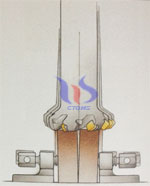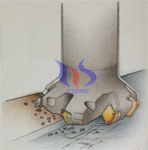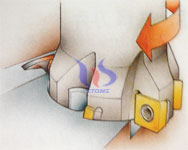Cemented Carbide Tool Milling Solutions
Milling prone to problems and possible solutions
Milling excessive vibration
1. Clamping poor
Possible solutions.
Assess the cutting force and support direction or improve clamping.
Milling cutting force is reduced by reducing the milling depth of cut.
Sparse teeth and different tooth pitch milling cutter to obtain a more positive cutting action.
L trough with small nose radius and parallel surfaces.
Select fine grain coating or thin coating blades
2. Workpiece is not firmly
Consider the square shoulder milling cutter trough has a positive rake angle (90 degree entering angle).
L trough blades
Lower axial cutting force - the use of low depth of cut, small nose radius and parallel surfaces.
Select sparsely toothed milling cutter has a different pitch.
3. Use a large overhang tool
Overhang as small as possible.
Use sparse teeth milling cutter having a different tooth pitch.
Balanced radial and axial cutting forces - the main angle of 45 degrees, a large nose radius or circular blade cemented carbide tool.
Increase the amount of feed per tooth
The use of light cutting insert geometry-L / M
4.Unstable spindle milling side shoulder
Select cemented carbide tool diameter as small as possible
Positive rake angle cemented carbide tool and blades
Try to conventional milling
Check spindle deviation to determine whether the machine can withstand
5 table feed irregular
Try to conventional milling
Tighten the machine feed device.
| Excessive vibration | Poor surface quality |
 |
 |
The milling surface quality is poor
1. Milling feed per revolution excessive
The axial adjustment cemented carbide tool or classification blades. check center high with a dial gauge.
Check the spindle run out and mounting surface cemented carbide tool.
Milling feed per revolution decreases to less than 70% of the width of the parallel forging.
If possible, use a wiper blades milling.
2. Milling vibration
3. BUE formed on milling inserts
Increase the milling cutting speed in order to improve the processing temperature.
Interrupt the supply of coolant.
Use the sharp milling cutting insert having a smooth rake face.
Use positive rake angle insert geometries.
Try to use higher cutting parameters cermet grades.
5 workpiece chipping
Reduce the milling feed rate per tooth.
Select a fine-toothed the superdense teeth cutting tools.
Repositioning of cemented carbide tool cemented carbide tool exit thinner chips.
Choose the most suitable main angle (45 degrees) and light cutting trough.
Select sharp cutting blades.
Monitoring flank wear in order to avoid excessive wear.
Conventional milling blades crack
1 blade exits the chip thickness is too large
By changing the position of the cemented carbide cutting tool relative to the workpiece, so that when the blades exit reduces chip thickness.
Use climb milling.
Reduce the amount of feed per tooth.
Select a smaller diameter cemented carbide tool.
Use a sturdy cutting insert trough (H).
| Conventional milling blades crack | Square shoulder milling blades crack |
 |
 |
Square shoulder milling blades crack
Conventional milling chips attached to the blades, the adhesion between the square shoulders milling edge.
Switch to climb milling.
Using compressed air Milling.
More sharp the milling cutting blades to promote the chip and then milling.
Monitoring flank faces wear in order to avoid excessive wear.
2. Climb milling multiple pass.
Consider one time to pass on the completion of the milling process.
3. Milling chip jamming square shoulders and cutting edge.
Try to conventional milling.
Select toughness grades.
Select horizontal milling machine milling.
Chinatungsten Online can provide various sizes and grades of cemented carbide cutting tools, non-standard products are also customized according to customer requirements. Welcome to consult and purchase sales@chinatungsten.com, sales@xiamentungsten.com .






 sales@chinatungsten.com
sales@chinatungsten.com